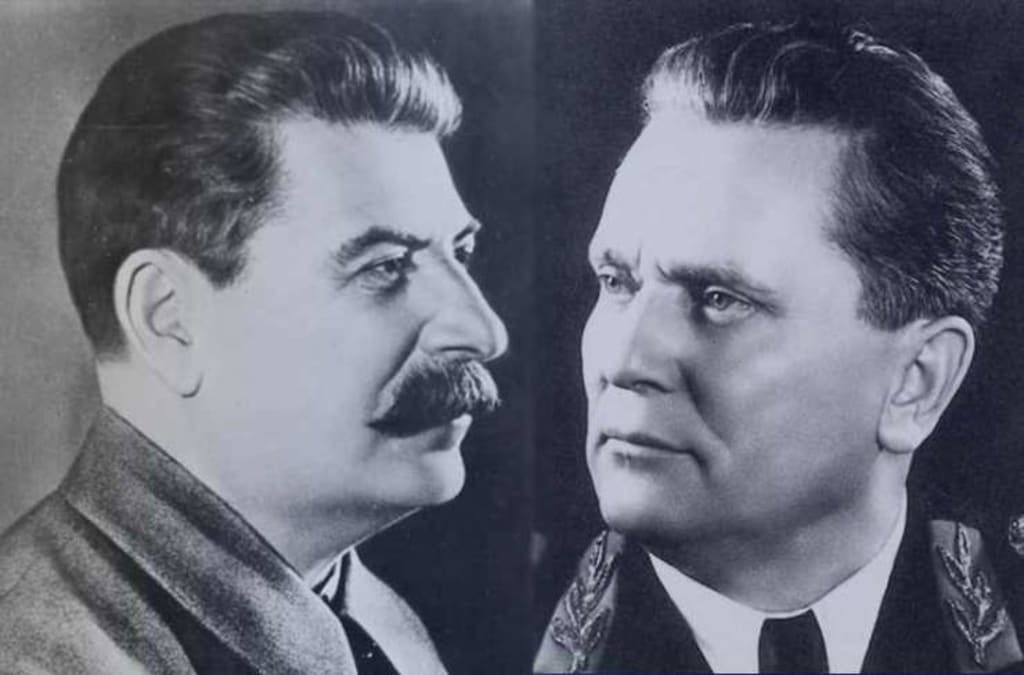The Tito-Stalin Split
Reasons and Consequences

What were the reasons for and consequences of the split between Yugoslavia and the Soviet Union in 1948?
On 28th June 1948, news of the Communist Party of Yugoslavia’s (CPY) expulsion from Cominform reverberated amongst the astounded Western world. Yugoslavia’s expulsion from Cominform, or Tito-Stalin split as it’s now entitled, marked a crack in the monolithic Soviet Bloc, whilst providing a future point of reference to those Communist party’s that wanted to become ideologically and politically emancipated from Moscow. In the upcoming essay, I am going to analyze the rationale behind the Tito-Stalin split, before evaluating the impact of the split; both on Yugoslavia’s development and the Eastern European Communist movement.
The official reason for Yugoslavia’s expulsion from Cominform was that Belgrade was pursuing a political line incompatible with Marxist-Leninism. The fact that all Soviet Bloc leaders claimed their legitimacy from ideology, meant that any conflicts inevitably had ideological roots. Letters were exchanged between the Soviet-Yugoslav hierarchy throughout March-May 1948. In these letters, the USSR consistently criticized Yugoslavia’s commitment to the Soviet model of socialism. The Yugoslav hierarchy responded by claiming they were in no-way deviating from Marxist-Leninist doctrine. One key attack on Yugoslavia’s commitment to the Marxist-Leninism, was the accusation that Yugoslavia was ‘permitting opportunism in policy towards Kulaks.’ This accusation was in relation to Yugoslavia’s decision in taking a less violent path towards Collectivization. Deputy Prime Minister Edvard Kardelj, who presided over the policy, proposed to create ‘general agriculture cooperatives’ which would incorporate all peasants. These agricultural cooperatives would be made-up of peasants farming their individual land. This both contradicted Lenin’s position; which professed that small individual farming gave birth to capitalism and the bourgeoise, and Stalin’s Constitution of the USSR; which advocated the abolition of ‘landlords, kulaks, merchants and usurpers who could exploit the peasants.’ The USSR’s anger towards this policy was outlined in a letter to the CPU, accusing Yugoslavia of disregarding the theory of class struggle and denying the proletariat a leading role in the revolution. The USSR also believed the Yugoslav Peoples Front (NF) was a deviation from true Marxist-Leninism. The NF was a political platform which brokered alliances with opposition factions. Stalin vehemently believed that the Peoples Front was where the true political power of Yugoslavia resided. This contradicted Marxist-Leninism, which professed that the party was to be the true power of a nation. Stalin arguably had a point; Tito himself stated ‘Does the Communist Party of Yugoslavia have any program different from the program of the People’s Front? No!’
The Tito-Stalin split was not altogether ideological in nature, personal and geo-political discrepancies were also a cause. Tito’s irredentist attitude in the Balkans, particularly in Albania and Macedonia, was incongruous with Stalin’s prerogative of strict hegemony in the region. Tito wanted to establish Yugoslavia as the regional hegemon in the Balkans. In seeking regional dominance, Tito hoped to resolve long-standing ethical and territorial tensions. Tito saw the incorporation of Albania as a solution to the Kosovar question, as it would ease Yugoslav concerns with the ethnic Albanian minority in Kosovo. Tito was concerned with the Kosovar Albanians as they refused to support the Peoples Front in World War Two. From 1947 Yugoslav influence in the region grew exponentially. The Yugoslav government provided ten thousand tons of grain to Albania, Yugoslav financial assistance accounted for nearly 57% of Albania’s national budget, and Albania was granted a financial subsidy worth about 10% of government revenue. The integration of the two economies led to Albania being reliant on Yugoslav patronage, with the CPY exerting almost total control over the Albanian state. In 1947, Stalin expressed his disagreement with Yugoslav policy in Albania, emphasizing that Albania should take care of its foreign policy independently. Stalin also suggested that Yugoslavia should first unify with Bulgaria. Due to Soviet influence in Bulgaria, unification would have been ‘a means for Soviet control over Yugoslavia.’ Tito firmly disobeyed this hierarchical subordination from Moscow, regarding unification with Bulgaria an attempt by Stalin to ‘force on him a Trojan horse.’
The Albania issue was undoubtedly a bilateral issue between Yugoslavia and the USSR. However, Tito’s support for the Greek partisan movement in the Greek Civil War would see a conflict of interests with Stalin and the West. According to Barker, the USSR had no real designs on Greece. This view is substantiated by the fact Greece evaded discussion altogether during the Molotov-Ribbentrop negotiations. After World War Two, Stalin had granted Churchill ‘90% predominance in Greece.’ Stalin believed that Soviet interest was superior to Yugoslav interest, therefore did not expect Belgrade to undermine the Soviet stance. Despite this, Tito followed a policy discordant with Stalin’s promise to Churchill. Tito encouraged the Greek December revolution, supplied arms to the Greek Communists, allowed Greek Partisans to seek refuge in Yugoslav territory, and even broadcast the ‘Free Greek’ Radio from Belgrade. In 1947, the Free Greek Radio broadcast the formation of the Free Greek Government in Grammos, led by Greek Communist Markos Vafiadis. This coincided with Yugoslavia’s General Staff requesting a military base in that same region. Stalin linked the two occurrences, believing Tito was setting up a Yugoslav satellite in the region.
The immediate consequence of the split was the purging of those deemed disloyal to both Yugoslavia and the USSR. Hungary’s Lazlo Rajk and Bulgaria’s Traisto Kostov were sentenced to death for displaying Titoist sympathies, and high ranking ministers from Poland, Czechoslovakia and Romania would seemingly disappear altogether. Petrovic hypothesizes that the key reason for Yugoslavia’s expulsion from Cominform, was to give Stalin an excuse to tighten his hold on the Eastern Bloc. Stalin’s purging of ‘Titoists’, and the fact that after Cominform expulsion Albania fell back into Soviet control, leads us to believe that Petrovic’s assumption is correct. Purges also took place in Yugoslavia, but on a much smaller scale. The majority of those arrested by the Tito regime were refugees fleeing from the USSR to Yugoslavia. Those fleeing from the USSR to Yugoslavia, believed Tito had ‘westernized views,’ which is another debate entirely. Very few government officials were actually purged in Yugoslavia, predominantly as Tito was primarily concerned with the Serbs, Croats and Montenegrins who shared an affinity with Russia. West postulates that Tito’s aim was to educate the detainees of his benevolence, however those familiar with Goli Otok may disagree.
Yugoslavia’s expulsion from Cominform would mark the inception of the Non-Aligned movement. Niebuhr argues that Tito’s search for non-aligned allies was an attempt to legitimize his hold over Yugoslavia. This assertion is rebuttable however, as after the 1948 split, Tito’s regime seemed to hold a great deal of legitimacy. Tito’s first ally would be Ethiopian Emperor Haile Selassie. The two countries benefitted from ‘economic assistance, educational exchanges and trade.’ This constructive alliance would gain attention from other countries who were concerned with the US, USSR and European Colonialism. Tito’s diplomatic tour of Egypt, Indonesia, Sri Lanka, Sudan and Cambodia, and especially the Bandung Conference in 1955, cemented international recognition for his regime. The Bandung Conference focused on the key tenets of the non-aligned movement, which in turn shaped Tito’s own domestic policies. Tito believed that by adopting a center-left, ‘market-capitalist’ stance, he could attract more people to the Non-Aligned Movement. By the Belgrade Conference in 1961, members of the Non-Aligned movement would make up 19% of Yugoslav foreign trade. In essence Tito had created a ‘Third World’ poised between the Cold War powers.
After World War Two, Yugoslavia was in desperate need of economic aid. Overproduction of goods and a lack of diversity between the industrial and service sectors, had effectively ruined Yugoslavia’s economy. Economic sanctions from the Eastern Bloc, post-Cominform expulsion, only intensified these economic issues. The US saw this crisis as an opportunity to provide economic support to Yugoslavia, thus, in theory, incentivizing other Soviet satellite states to defect. Furthermore, through providing aid to Yugoslavia, the US would gain a strategic weapon in Cold War conflict. Huge loans from the West failed to improve Yugoslavia’s economy, therefore in return for Western aid, the US instructed Tito to overhaul the Yugoslav economy entirely. The Yugoslav economy became even more decentralized than in the days of the monarchy, with capitalist free-market economics taking shape. The economic overhaul weakened the CPY’s stranglehold over politics, whilst establishing Tito as the West’s key to the Eastern Bloc. In addition to economic aid, the US also became the main supplier of arms to Yugoslavia. In the USA’s 1951-1952 military budget, the US allotted a $63,000,000 surplus to the Yugoslavian arms trade. The CIA trained and supported Yugoslav intelligence agents in order to prevent KGB operations in Yugoslavia. This new covert alliance would be demonstrated in the Korean War, when the CIA used its Yugoslav ties to form counter operations.
Stalin’s attempt to marginalize Tito through Cominform expulsion would ultimately be in vain. Tito became a world-renowned socialist monolith, creating the non-aligned third world and manufacturing a new form a socialism that would rival Marxist-Leninism itself. Tito bridged the gap between the Communist East and the Capitalist West, providing the blueprint for those Soviet satellites who wished to become politically and ideologically emancipated from the USSR. However disputed his legacy may be, Tito’s defiance, in light of Stalinist coercion, undoubtedly remained a point of inspiration until the USSR’s collapse in 1991.






Comments
There are no comments for this story
Be the first to respond and start the conversation.